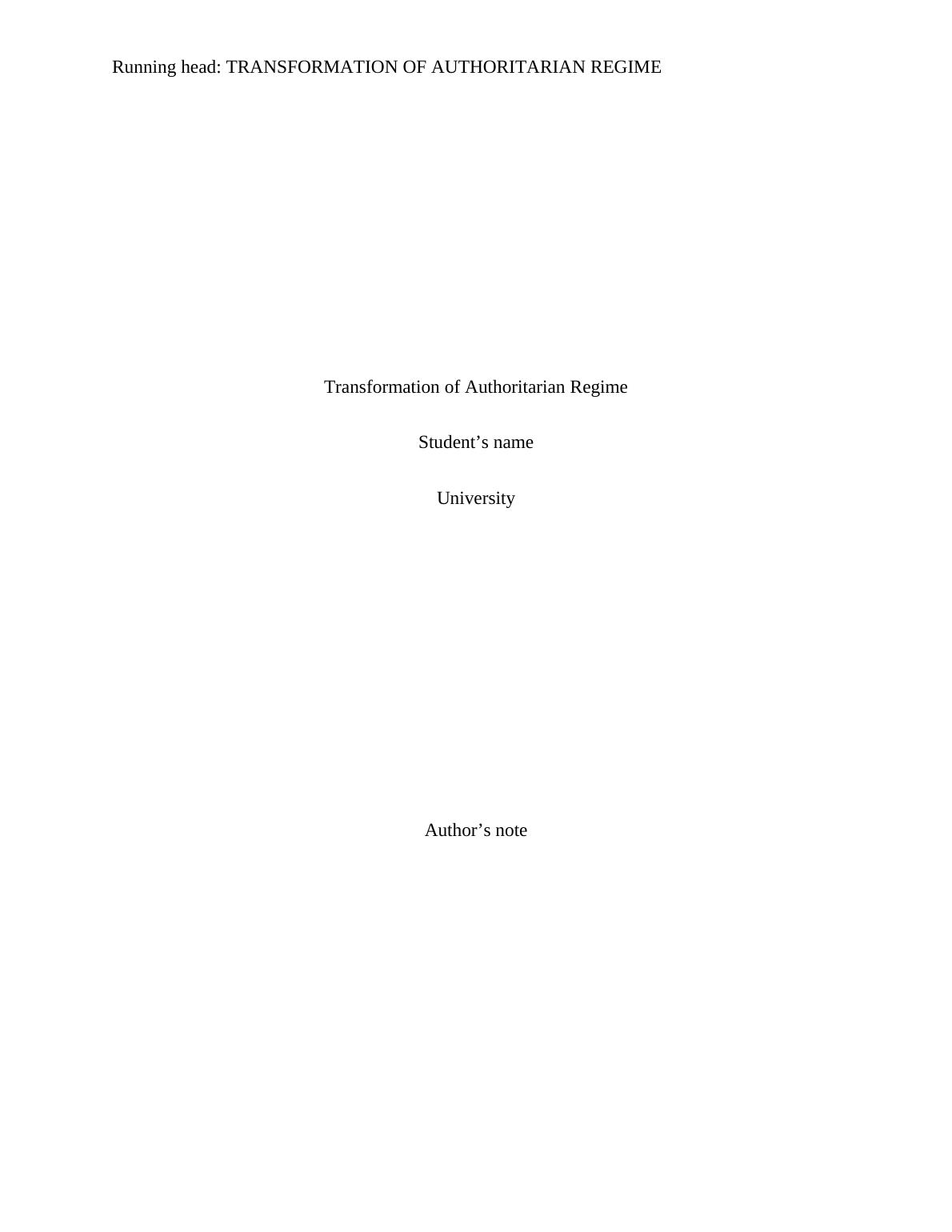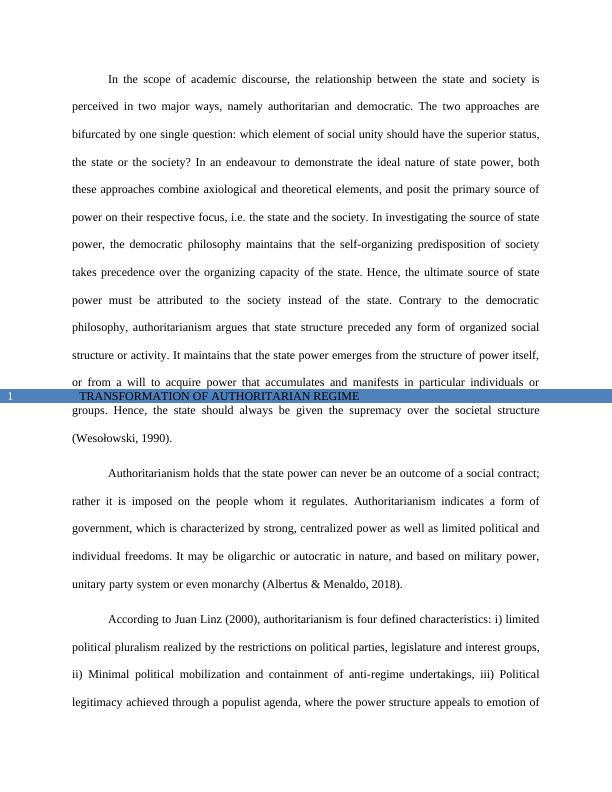Assignment on Transformation of Authoritarian Regime
Added on 2022-09-14
7 Pages1621 Words11 Views
Running head: TRANSFORMATION OF AUTHORITARIAN REGIME
Transformation of Authoritarian Regime
Student’s name
University
Author’s note
Transformation of Authoritarian Regime
Student’s name
University
Author’s note

TRANSFORMATION OF AUTHORITARIAN REGIME1
In the scope of academic discourse, the relationship between the state and society is
perceived in two major ways, namely authoritarian and democratic. The two approaches are
bifurcated by one single question: which element of social unity should have the superior status,
the state or the society? In an endeavour to demonstrate the ideal nature of state power, both
these approaches combine axiological and theoretical elements, and posit the primary source of
power on their respective focus, i.e. the state and the society. In investigating the source of state
power, the democratic philosophy maintains that the self-organizing predisposition of society
takes precedence over the organizing capacity of the state. Hence, the ultimate source of state
power must be attributed to the society instead of the state. Contrary to the democratic
philosophy, authoritarianism argues that state structure preceded any form of organized social
structure or activity. It maintains that the state power emerges from the structure of power itself,
or from a will to acquire power that accumulates and manifests in particular individuals or
groups. Hence, the state should always be given the supremacy over the societal structure
(Wesołowski, 1990).
Authoritarianism holds that the state power can never be an outcome of a social contract;
rather it is imposed on the people whom it regulates. Authoritarianism indicates a form of
government, which is characterized by strong, centralized power as well as limited political and
individual freedoms. It may be oligarchic or autocratic in nature, and based on military power,
unitary party system or even monarchy (Albertus & Menaldo, 2018).
According to Juan Linz (2000), authoritarianism is four defined characteristics: i) limited
political pluralism realized by the restrictions on political parties, legislature and interest groups,
ii) Minimal political mobilization and containment of anti-regime undertakings, iii) Political
legitimacy achieved through a populist agenda, where the power structure appeals to emotion of
In the scope of academic discourse, the relationship between the state and society is
perceived in two major ways, namely authoritarian and democratic. The two approaches are
bifurcated by one single question: which element of social unity should have the superior status,
the state or the society? In an endeavour to demonstrate the ideal nature of state power, both
these approaches combine axiological and theoretical elements, and posit the primary source of
power on their respective focus, i.e. the state and the society. In investigating the source of state
power, the democratic philosophy maintains that the self-organizing predisposition of society
takes precedence over the organizing capacity of the state. Hence, the ultimate source of state
power must be attributed to the society instead of the state. Contrary to the democratic
philosophy, authoritarianism argues that state structure preceded any form of organized social
structure or activity. It maintains that the state power emerges from the structure of power itself,
or from a will to acquire power that accumulates and manifests in particular individuals or
groups. Hence, the state should always be given the supremacy over the societal structure
(Wesołowski, 1990).
Authoritarianism holds that the state power can never be an outcome of a social contract;
rather it is imposed on the people whom it regulates. Authoritarianism indicates a form of
government, which is characterized by strong, centralized power as well as limited political and
individual freedoms. It may be oligarchic or autocratic in nature, and based on military power,
unitary party system or even monarchy (Albertus & Menaldo, 2018).
According to Juan Linz (2000), authoritarianism is four defined characteristics: i) limited
political pluralism realized by the restrictions on political parties, legislature and interest groups,
ii) Minimal political mobilization and containment of anti-regime undertakings, iii) Political
legitimacy achieved through a populist agenda, where the power structure appeals to emotion of

TRANSFORMATION OF AUTHORITARIAN REGIME2
the masses posing as the only saviour from the purported necessary evils such as insurgency,
anti-nationalism, underdevelopment etc. and most importantly, iv) Vague administrative and
executive powers that enables the executive realm to exert power beyond a defined jurisdiction.
In this regard, authoritarianism systematically promotes a suppression of anti-establishment
activities and lacks the opportunity of fair and competitive elections to executives, legislature or
both. In a wider sense, authoritarian regimes essentially lack civil liberties such as freedom of
expression, freedom of religion and several other democratic features that allows the civil society
to directly or indirectly take part in the political process.
In the history of human civilization, there are several instances of authoritarian regimes
which have held a major influence in the national politics. However, with time, almost all of
such regimes have destabilized or transformed into a more democratic institutions. Even in the
modern history, the world experienced a rise of authoritarian regimes since 1946 in various
countries, although they trend declined gradually until 2000. It has been observed historically
that the transformation or downfall of authoritarian regimes are majorly initiated by organized
public revolts and emerged from a demand of change from the systematic injustice, suppression
and deprivation embedded in such political structures. Evidences form Egypt, Argentina and
Belarus etc. all corroborates with this assumption (Motadel, 2019).
In the light of the public demands that initiate an uprising against authoritarian regimes,
the factors underlying the transformation of authoritarian rule could be identified as the flaws
and injustice inherent in such systems. Authoritarianism is essentially characterized by
centralized and concentrated power of the state, which is exercised and maintained by the
exclusion of political opponents and political repression. In this regard, political scientist Adam
Przeworski (2017) has contended that authoritarian equilibrium rests majorly on fear, lies and
the masses posing as the only saviour from the purported necessary evils such as insurgency,
anti-nationalism, underdevelopment etc. and most importantly, iv) Vague administrative and
executive powers that enables the executive realm to exert power beyond a defined jurisdiction.
In this regard, authoritarianism systematically promotes a suppression of anti-establishment
activities and lacks the opportunity of fair and competitive elections to executives, legislature or
both. In a wider sense, authoritarian regimes essentially lack civil liberties such as freedom of
expression, freedom of religion and several other democratic features that allows the civil society
to directly or indirectly take part in the political process.
In the history of human civilization, there are several instances of authoritarian regimes
which have held a major influence in the national politics. However, with time, almost all of
such regimes have destabilized or transformed into a more democratic institutions. Even in the
modern history, the world experienced a rise of authoritarian regimes since 1946 in various
countries, although they trend declined gradually until 2000. It has been observed historically
that the transformation or downfall of authoritarian regimes are majorly initiated by organized
public revolts and emerged from a demand of change from the systematic injustice, suppression
and deprivation embedded in such political structures. Evidences form Egypt, Argentina and
Belarus etc. all corroborates with this assumption (Motadel, 2019).
In the light of the public demands that initiate an uprising against authoritarian regimes,
the factors underlying the transformation of authoritarian rule could be identified as the flaws
and injustice inherent in such systems. Authoritarianism is essentially characterized by
centralized and concentrated power of the state, which is exercised and maintained by the
exclusion of political opponents and political repression. In this regard, political scientist Adam
Przeworski (2017) has contended that authoritarian equilibrium rests majorly on fear, lies and

End of preview
Want to access all the pages? Upload your documents or become a member.
Related Documents
Business Law Assignment - German legal systemlg...
|10
|2567
|421
Are Nations Really Born in Warlg...
|13
|4453
|428
IDEOLOGY ESSAY IDEOLOGY ESSAY Name of the student Name of thelg...
|4
|670
|123
Strategic Outlook of Afghanistan: Political Structure, Economy, and Key Challengeslg...
|7
|1070
|411
Political Science - Democratic Foundation in USlg...
|4
|694
|23
Red Scares: A Comparison of the First and Second Red Scare in the USlg...
|9
|3021
|133
